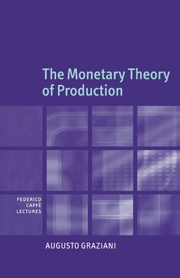Book contents
7 - Real and monetary interest
Published online by Cambridge University Press: 03 July 2009
Summary
The theory of the real interest rate
The transition from a traditional model, where, in equilibrium, the only stock of money existing is money created by the government sector, to an enlarged model allowing for the existence, also in equilibrium, of credit money supplied by the banks, produces at least one remarkable consequence concerning the doctrine of real and monetary interest rates.
The received doctrine can be synthetically set forth as follows. Anyone granting a money loan runs the risk of seeing the purchasing power of money eroded by inflation in the interval between the time the loan is granted and the time the loan is repaid. If this happens, the loaner gets back a sum having a lower real value than the sum initially lent, and so suffers a capital loss. In order to avoid a loss, the loan should be adequately indexed in order to eliminate the influence of any possible increase in the level of money prices.
Two possible kinds of indexation are conceivable: real and financial.
Real indexation (or ex-post indexation, or indexation on capital) is an agreement that the basis for the annual interest payments is r, the rate that would prevail with no inflation, and that an extra repayment linked to inflation will be made at the end of the loan, when the principal is revalued according to such inflation as may have occurred.
- Type
- Chapter
- Information
- The Monetary Theory of Production , pp. 129 - 137Publisher: Cambridge University PressPrint publication year: 2003



